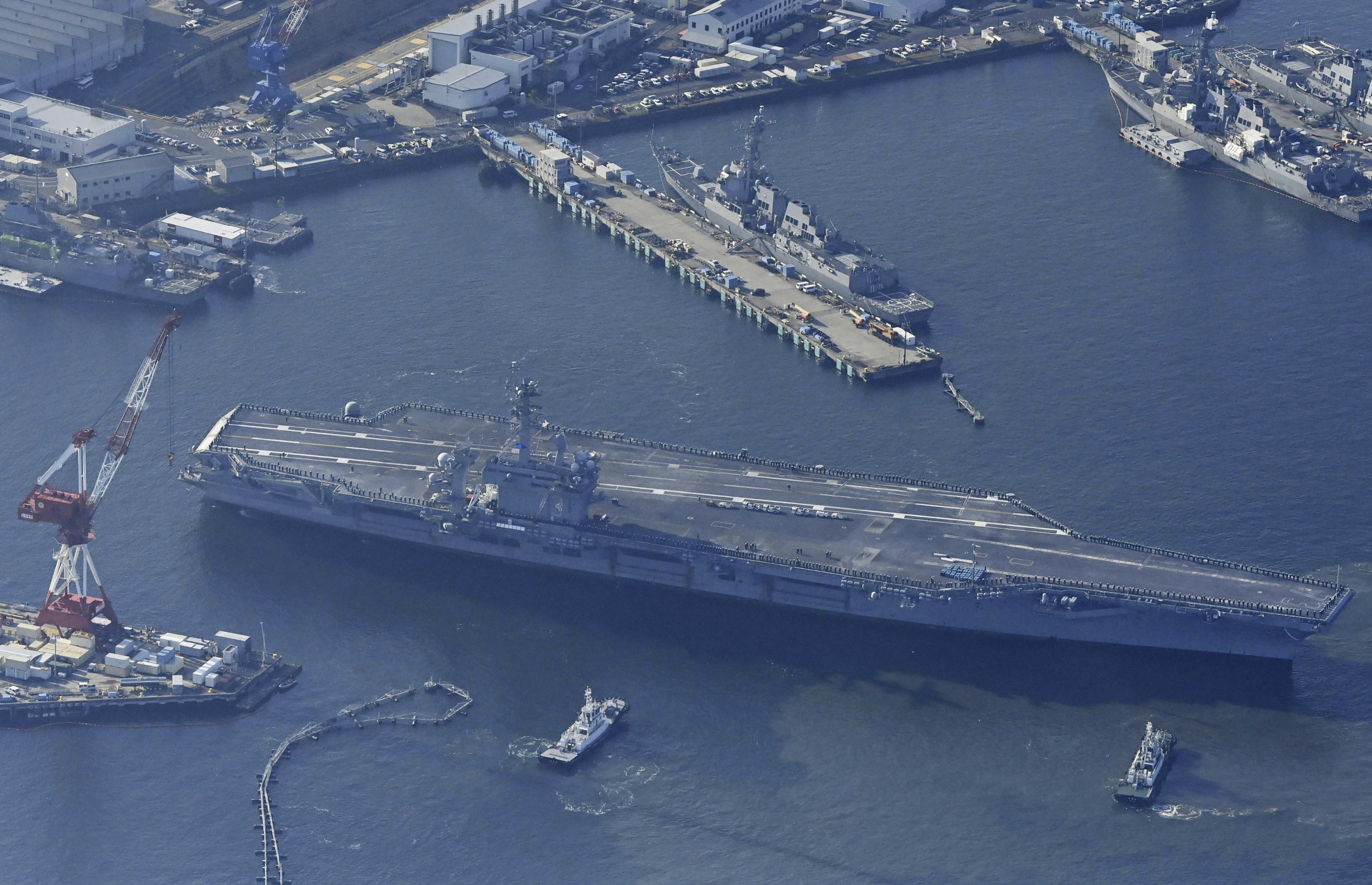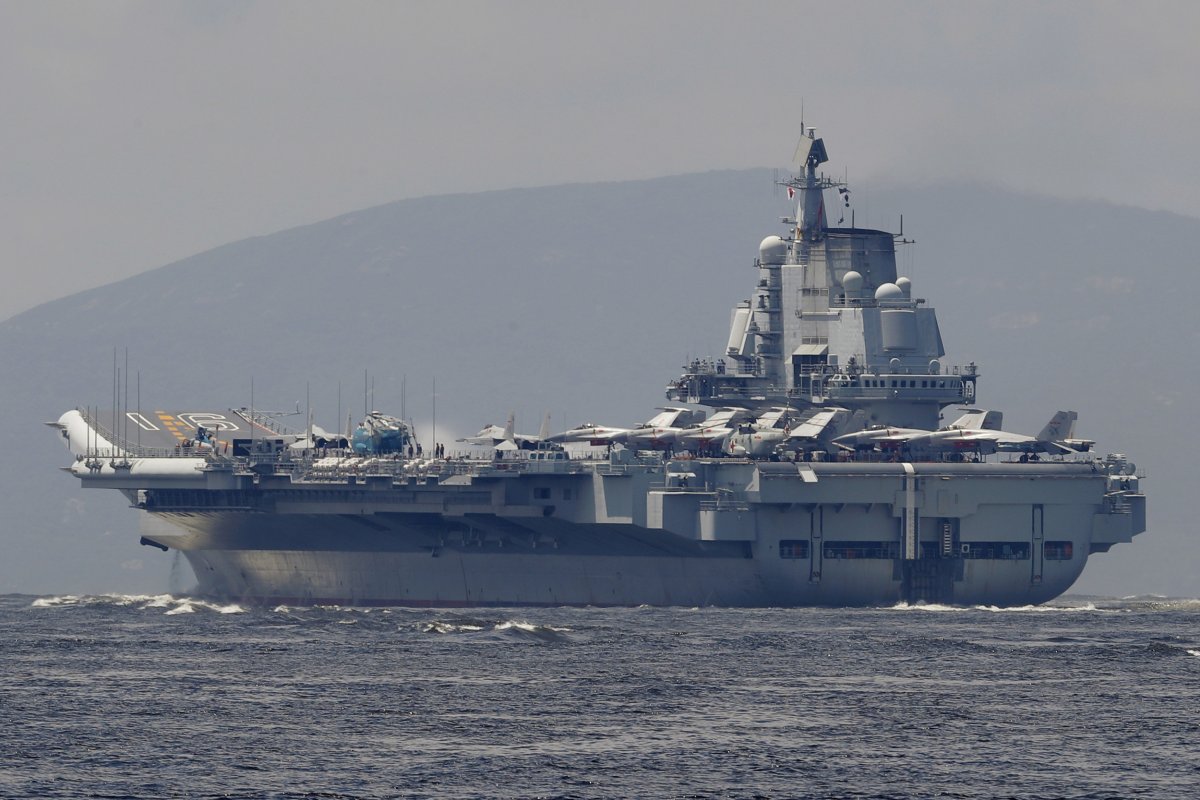
Both the United States and China deployed their aircraft carriers in the Western Pacific Ocean on Sunday, as Washington and Beijing jostle for naval dominance in the region.
Newsweek has reached out to the Chinese Defense Ministry for comment by email.
Why It Matters
The U.S. Navy aircraft carrier USS George Washington returned to its home port in Japan—Yokosuka naval base near Tokyo—last November, after undergoing maintenance in Virginia since 2017, serving as one of the forward-deployed American warships to the allied country.
Meanwhile, China is challenging the First Island Chain—formed by Japan, Taiwan, and the Philippines under the U.S. containment strategy meant to keep China’s forces in check—with a fleet of more than 370 naval vessels, including two aircraft carriers in active service.
Kyodo News via AP
What To Know
Photos shared on X, formerly Twitter, by a ship spotter in Japan on Sunday show the George Washington leaving its home port for sea trials. Its departure was also confirmed by a local government website that tracks visits by U.S. nuclear-powered naval vessels to Yokosuka.
Lieutenant Commander Mark Langford, a public affairs officer aboard the George Washington, told Newsweek that the aircraft carrier was underway conducting “routine operations” in the U.S. Seventh Fleet area of operations, which covers the Western Pacific and Indian Oceans.
This marked the first time the nuclear-powered aircraft carrier had left Yokosuka since its return seven months ago. The departure comes as aircraft assigned to the warship conduct field carrier landing practice on Iwo To, a Japanese island located 750 miles south of Tokyo.
原子力空母「ジョージ•ワシントン (USS George Washington)」、海上公試のため横須賀基地を出港しました! pic.twitter.com/IITFV7avR5
— ⚓︎アルザス⚓︎ (@Alsace_class) May 25, 2025
While the American aircraft carrier was underway in waters near Japan, the Chinese aircraft carrier CNS Liaoning was spotted operating 124 miles north of Kuba Island—part of Japan’s southwestern Senkaku Islands—the Joint Staff of the Japanese Defense Ministry announced.
The uninhabited Senkaku Islands, also known as the Diaoyu Islands in China, are claimed by Beijing, which has intensified its assertive coast guard patrols since Tokyo nationalized the islands in 2012. The U.S. ally has accused China of attempting to alter the status quo.
The Liaoning was joined by four other Chinese warships in the East China Sea, according to the report, including Type 052D destroyers CNS Qiqihar and CNS Tangshan, as well as Type 054A frigates CNS Binzhou and CNS Anyang, which were identified by hull numbers.
#海上自衛隊 は、令和7年5月25日(日) 中国海軍クズネツォフ級空母「遼寧」ルーヤンⅢ級ミサイル駆逐艦x2及びジャンカイⅡ級フリゲートx2の計5隻が、久場島(沖縄県)の北約200kmの海域において航行しており、艦載戦闘機及び艦載ヘリの発着艦を確認しました。#防衛省・自衛隊… pic.twitter.com/KlgusLVbnM
— 防衛省統合幕僚監部 (@jointstaffpa) May 25, 2025
“Takeoff and landing of carrier-based fighter jets and helicopters was confirmed,” said the Japan Joint Staff, adding that a ship and an aircraft assigned to the Japan Maritime Self-Defense Force, as well as fighter jets of the Japanese air force, were deployed in response.
What People Are Saying
The U.S. Navy previously said: “George Washington is [Seventh] Fleet’s premiere forward-deployed aircraft carrier, a long-standing symbol of the United States’ commitment to maintaining a free and open Indo-Pacific region, and operates alongside allies and partners across the U.S. Navy’s largest numbered fleet.”
Japan’s defense white paper commented: “China has been rapidly building up military capabilities while intensifying its activities in the East China Sea, where the waters surrounding the Senkaku Islands are, as well as in the Pacific.”
The Chinese Defense Ministry previously responded: “Japan has been closely tracking, monitoring, and interfering with Chinese vessels and aircraft for a long time, jeopardizing the safety of Chinese vessels and aircraft and easily causing maritime and air security problems.”
What Happens Next

Kin Cheung/AP Photo
It remains to be seen whether the Chinese aircraft carrier will pass through the Miyako Strait from the East China Sea and head toward the Philippine Sea, thereby breaching the island chain.
